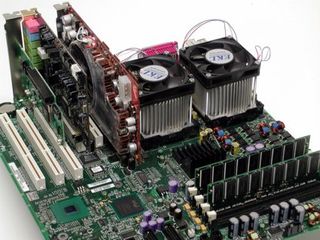Your Own Server Part 2: Windows Server 2003 Installation
What'll It Be? Server Hardware

It doesn't always have to be a Dual-Xeon with expensive ECC memory and 64-bit PCI-X as we use here. For a server in the office, it is sufficient to have a small Pentium 4 with enough memory and a RAID array for protection against faults in the hard drive.
At this point, we are not going to start a detailed essay on the pros and cons of specific components. Instead, we want to discuss a few basics so that we can then directly continue with the Windows installation.
In principle, any computer is acceptable as a Windows server, provided it complies with the minimum requirements. Naturally, specific requirements will arise depending on the desired tasks that are to be performed. For example, databases or mail servers are very memory-intensive and therefore a lot of RAM must be provided. For a file server, the hard disks must be a certain size.
While some users may have the budget to invest in machines with four Itanium, Opteron or Xeon processors due to the demands of specific applications, one- and two-processor servers are the most widely sold in the server sector. AMD's Opteron is slowly gaining momentum, while the Xeon from Intel has been a popular choice for small servers.
The Xeon and Pentium 4 are rather closely related, which is why we can certainly recommend a single Pentium 4 with Hyper Threading for simple server systems in small and medium-sized companies, because they offer high performance and have numerous mature platforms. AMD is somewhat losing out because the current chip set is mainly designed for multimedia tasks. In case of doubt, we recommend taking a "small" Opteron, because they are at least on a par with equally expensive Intel chips and sometimes even better - and they offer 64-bit processing.
Depending on the importance and desired availability of the server, a UPS (uninterruptible power supply), a redundant power supply, as well as a RAID array should also be on the shopping list.
In addition, we also want to mention the possible network interfaces of a server. If the computer will only be used for an Intranet, then in most cases one network controller is adequate. Here, in any case, we recommend gigabit-compatible models, which are already integrated into many motherboards. If the server is also used to access the Internet, a second network card becomes necessary.
Stay on the Cutting Edge
Join the experts who read Tom's Hardware for the inside track on enthusiast PC tech news — and have for over 25 years. We'll send breaking news and in-depth reviews of CPUs, GPUs, AI, maker hardware and more straight to your inbox.
Current page: What'll It Be? Server Hardware
Prev Page Windows - Sometimes It's Hard To Grasp Next Page Windows Installation: Preparations-
I need to how to install SCCM ( System Center Configuration Manager) basic installation step by step guide with images or screenshots. This is help full to all IT staffesReply
Most Popular

